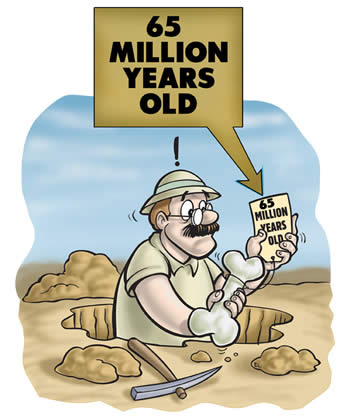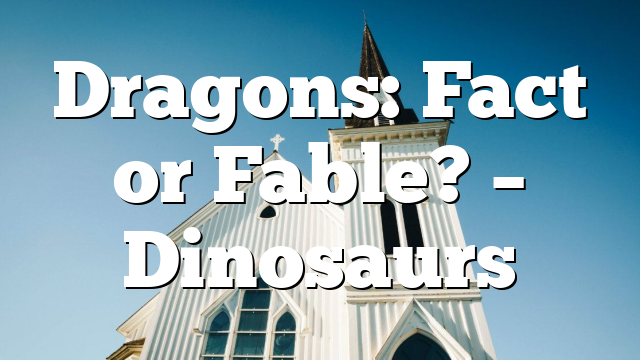Click to join the conversation with over 500,000 Pentecostal believers and scholars
Click to get our FREE MOBILE APP and stay connected
| PentecostalTheology.com




Dragons and Humans—Together?
For evolutionists, legends of men slaying dragons must be mythical because their timeline has creatures like dinosaurs die out over 60 million years before humans existed. But dragon accounts aren’t easy to dismiss as mere fantasy.
Dragons are memorialized in legends, historical accounts, and artwork from around the world. To name a few, there’s an Aboriginal depiction of a water monster that resembles a plesiosaur, an ancient historical account of serpents in Egypt with bat-like wings, the epic poem Beowulf with its account of a fiery flying serpent, and Native American petroglyphs (etchings in stone) that resemble dragons. Dragons are depicted on flags, emblems, tapestries, maps, pottery, pictographs, and more.
Although from disconnected cultures, the descriptions are remarkably similar—perhaps because dragons were real? Find out more at the Creation Museum’s new dragon exhibit. Filled with colorful artwork and artifacts, intriguing dragon legends, and a couple of 60-foot-long Chinese dragons, this exhibit asks visitors the question, “Were dinosaurs dragons?”
Starting with the Bible
Biblical creationists are not surprised by artifacts depicting dragons or the worldwide accounts of dragons living among men—that idea is consistent with the Bible. Genesis 1 tells us that on Day Five of Creation God created great “sea creatures” (Hebrew word tanninim, a word we’ll explore below) and flying creatures, so this would have included swimming pliosaurs and flying pterodactyls, which we would call dragons. God made land animals, including dinosaurs and other land dragons, on Day Six, the day He created man. So man lived among these awesome creatures from the beginning.
Does the Bible mention dragons? Used multiple times in Scripture, the Hebrew word tannin is defined by The Enhanced Brown-Driver-Briggs Hebrew and English Lexicon as “serpent, dragon, sea-monster.” It likely refers to certain reptiles, including giant marine creatures and serpentine land animals. Though translated several different ways and differing in precise meanings based on context, tannin can denote a dragon and therefore can potentially refer to a dinosaur since all dinosaurs are dragons (though not all dragons are dinosaurs by definition). Most land tannin/tanninim in Scripture likely refer to serpentine creatures as described in this semi-technical article, which lists all the uses of tannin in Scripture.

The new dragon exhibit virtually fills the large portico of the Creation Museum with dragons and dragon-related displays!
Why isn’t tannin translated as “dragon” in some more recent English versions? Perhaps it is due to many misunderstandings about what dragons really were. In other similar instances we find that translations list elephant or hippopotamus in the footnotes in Job 40 when discussing behemoth. Let’s look closer at the behemoth to give you some context. In the book of Job, God describes the behemoth that “eats grass like an ox
” and “moves his tail like a cedar
” with bones that “are like beams of bronze
” (Job 40:15–18). The beast the passage describes fits well with something similar to a sauropod dinosaur like Brachiosaurus.
Next, God describes at length a leviathan, a fire-breathing sea monster with impenetrable scales that none could face except its Creator. Read Job 41 and see if you picture a ferocious marine reptile, like a Kronosaurus. Leviathan is mentioned in five passages of Scripture and is identified as a type of tannin in Psalm 74:13–14 and Isaiah 27:1. Dragons are real—created creatures, some of which terrorized in the waters and others that roved the land and air.
Explore the dragon stories from around the world with this video from the Creation Museum.
So How Are Dinosaurs Explained?
The word dinosaur wasn’t even around until scientist Sir Richard Owen introduced it in the mid-1800s. Before then, large reptiles were called dragons. But the term dinosaur is more narrow, referring only to reptilian land animals whose hip structures raise them off the ground. So dinosaurs, we would say, are specific types of dragons.
But Fire-Breathing? Come On!
The burden against the beasts of the South. Through a land of trouble and anguish, From which came the lioness and lion, The viper and fiery flying serpent, They will carry their riches on the backs of young donkeys, And their treasures on the humps of camels, To a people who shall not profit. (Isaiah 30:6)
Many dragon legends such as what we find outside the Bible could be embellished, but the basic characteristics of dragons can be found in known creatures. Some dragon descriptions fit well with certain dinosaurs. Fossil pterosaurs reveal dragon-like wings. Certain beetles shoot out burning chemicals, so is a fire-breathing dragon really that far-fetched?
What Happened to the Dragons?
Land and air dragons would have been taken on Noah’s Ark and probably existed for some time afterward, based on the descriptions we see in the Bible and legends and artifacts worldwide. But they died out due to the curse of sin, with factors such as environmental and habitat changes, food source problems, genetic mutations, and diseases. Also, man most likely played a role in the demise of dragons, as we read in the legends of dragon slayers.
A Deadly Dragon Is Still Prowling!
We have a very real enemy who is called a dragon (Revelation 12:9). His trickery led the human race into sin, and he’s still deceiving and devouring today (1 Peter 5:8; 1 John 5:19). In 1 John, we find an unsettling test that divides people into one of two camps—the children of the devil or the children of God:
Whoever makes a practice of sinning is of the devil, for the devil has been sinning from the beginning. The reason the Son of God appeared was to destroy the works of the devil. No one born of God makes a practice of sinning, for God’s seed abides in him, and he cannot keep on sinning because he has been born of God. By this it is evident who are the children of God, and who are the children of the devil: whoever does not practice righteousness is not of God, nor is the one who does not love his brother. (1 John 3:8–10, ESV)
You cannot defeat this dragon on your own. As prophesied in Genesis 3:15, we needed Jesus to crush the head of this serpent. Through repentant faith in Christ and His work on the Cross and Resurrection from the dead, we can become children of God (John 1:12). Then we can rejoice with the Apostle John as overcomers “because He who is in you is greater than he who is in the world
” (1 John 4:4).
For More Information
- Dragon Legends—Truths Behind the Tales
- Tannin: Sea Serpent, Dinosaur, Snake, Dragon, or Jackal?
- Dragons: Legends & Lore of Dinosaurs
- Dinosaurs & Dragon Legends
- Hank Hanegraaff’s Abuse of Biblical Truth
- The Dragons of Peru
A Popular Science article suggests that dragons are not necessarily mythological but have a biology based in the “real world” (although not all dragon characteristics are found in a single creature).1 The article states that “most classic dragon characteristics do exist in other species.” Some beetles, for example, display something akin to breathing fire when they shoot chemicals from their abdomen and burn a threatening creature (or human). In addition, studies of fossil pterosaurs show that they had dragon-style wings.

Creationists have a logical explanation for dragon legends and argue that these creatures are not mythological at all. Some Bible versions mention “dragons” in several places, and many different and widely separated cultures have legends of people encountering dragons. Although they are sometimes fanciful, these accounts depict dragons as dinosaur-like. But the most compelling case for real historical dragon-human interaction is found in Genesis: land animals were created on Day Six of Creation Week, as was Adam, and so dinosaurs (also known as dragons) were made alongside man.




Anonymous
DID YOU KNOW there ARE _dino fire dragons_ in the BIBLE? @everyone
Anonymous
Troy Day yes. Job 41.
Anonymous
The last part of Job 40 is pretty interesting and cool as well.
Anonymous
Jason King tell us ALL you know about it for now
Anonymous
Troy Day I wish I could. But I have to go to work. Leviathan is in 41 and Behemoth is in 40. I will say whales don’t have scales nor do they breathe fire. So that leaves something else. Also a cedar is a pretty good sized tree. An elephant and a hippopotamus both have small tails. Smaller than a cedar tree.
Anonymous
Troy Day not sure
Anonymous
Ray James I agree.
Anonymous
Jeff Evensen how did you figure?
Anonymous
Troy Day notifies everyone in the group
Anonymous
Jeff Evensen it is interesting that youVE never said anything in our group but quickly responded to this general notification from FB groups
Anonymous
More of an observer. Interested to hear what is being discussed in the Pentecostal world.
Anonymous
very interesting internet-psychological behavior for sure
Anonymous
Troy Day Yes, Leviathan. Give me a time machine and a camera!
Anonymous
Duane L Burgess A word of caution to those Christians who are critical of the vast majority of Christian leaders and Christian movements today: the same judgment you use on others will be used against you. A little humility goes a long way here. Perhaps you’re not the only one who is right?
Anonymous
Count me in
Anonymous
Napita To to eat a dragon?
Anonymous
Facts
Anonymous
Marco Polo describes dinosaurs as coexisting too.
Anonymous
“Can you draw out Leviathan with a fishhook? Or press down his tongue with a cord? Can you put a rope in his nose Or pierce his jaw with a hook? Will he make many supplications to you, Or will he speak to you soft words? Will he make a covenant with you? Will you take him for a servant forever? Will you play with him as with a bird, Or will you bind him for your maidens? Will the traders bargain over him? Will they divide him among the merchants? Can you fill his skin with harpoons, Or his head with fishing spears? Lay your hand on him; Remember the battle; you will not do it again! Behold, your expectation is false; Will you be laid low even at the sight of him? No one is so fierce that he dares to arouse him; Who then is he that can stand before Me? Who has given to Me that I should repay him? Whatever is under the whole heaven is Mine. “I will not keep silence concerning his limbs, Or his mighty strength, or his orderly frame. Who can strip off his outer armor? Who can come within his double mail? Who can open the doors of his face? Around his teeth there is terror. His strong scales are his pride, Shut up as with a tight seal. One is so near to another That no air can come between them. They are joined one to another; They clasp each other and cannot be separated. His sneezes flash forth light, And his eyes are like the eyelids of the morning. Out of his mouth go burning torches; Sparks of fire leap forth. Out of his nostrils smoke goes forth As from a boiling pot and burning rushes. His breath kindles coals, And a flame goes forth from his mouth. In his neck lodges strength, And dismay leaps before him. The folds of his flesh are joined together, Firm on him and immovable. His heart is as hard as a stone, Even as hard as a lower millstone. When he raises himself up, the mighty fear; Because of the crashing they are bewildered. The sword that reaches him cannot avail, Nor the spear, the dart or the javelin. He regards iron as straw, Bronze as rotten wood. The arrow cannot make him flee; Slingstones are turned into stubble for him. Clubs are regarded as stubble; He laughs at the rattling of the javelin. His underparts are like sharp potsherds; He spreads out like a threshing sledge on the mire. He makes the depths boil like a pot; He makes the sea like a jar of ointment. Behind him he makes a wake to shine; One would think the deep to be gray-haired. Nothing on earth is like him, One made without fear. He looks on everything that is high; He is king over all the sons of pride.”
Job 41:1-34 NASB1995
And this was God speaking to Job.
Anonymous
Fact
Anonymous
Thank you for the information
Anonymous
There is no reason Job considering Leviathan should be fictional. Other written history confirms it too.
Anonymous
Karsten Wille tell us the truth pls
Anonymous
The term “dinosaur” did not appear until about 1840. Scripture talks about “dragons.” We see, for example, Behemoth and Leviathan.
They were air breathing, land dwelling creatures, created on Day Six.
That also means that some dragons went onto the Ark.
They would be young and small, for the purpose of repopulating the earth after Noah’s flood.
Some dragons, living hundreds of years, kept growing and growing leaving the huge fossilized skeletons after perishing in Noah’s Flood.
Those who survived the Flood died out or were hunted to extinction.
Meanwhile, consider the Komodo dragons today.
Anonymous
the bible says dragons, unicorns, and dinosaurs exist, so I am inclined to believe these are real in some manner. But he bible even suggests the Lochness Monster is real.